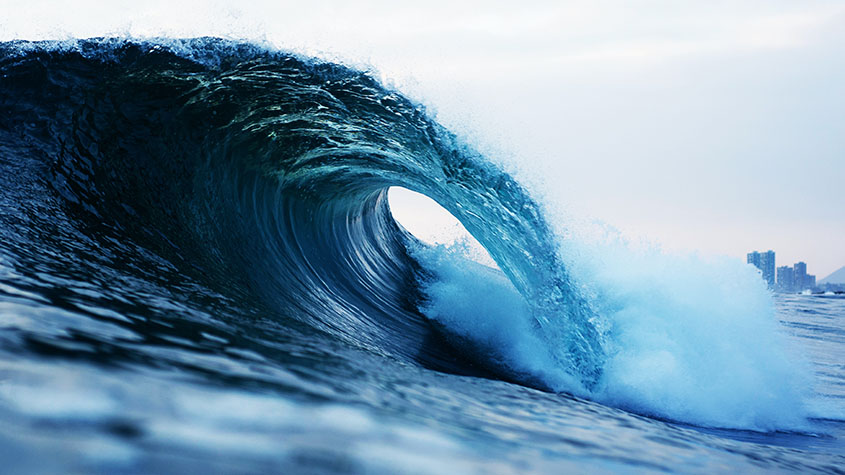Designing the Future of Wave Energy
Four NREL-Supported Marine Energy Projects Help Advance Technologies To Better Serve an Evolving Grid
Along global coastlines, a powerful force churns. Ocean waves contain tremendous amounts of power; in the United States, ocean waves carry the equivalent of almost 60% of the United States' annual electricity needs. But before the country (and the world) can tap into that well of power, we need a new fleet of technologies to harness those waves—affordably.
The marine energy team at the National Renewable Energy Laboratory (NREL) recently lent their expertise to four different projects focused on that very challenge. As part of a $24.9 million funding opportunity from the U.S. Department of Energy’s Water Power Technologies Office (WPTO), NREL researchers helped project partners improve the performance of four different wave energy converter designs.

The four wave energy converters, which transform the power from ocean waves into electrical energy, are being designed for in-water, grid-connected testing at the PacWave South test site, currently under construction off the coast of Oregon. As part of that design process, NREL researchers provided expert guidance and facilities to ensure technology designs can withstand the test site’s powerful waves.
“Developing and testing marine energy technologies is inherently complex,” said Mike Lawson, who leads the NREL marine energy team. “But with our lab’s wave energy experts, testing facilities, and modeling capabilities, developers can design devices that will operate in the harsh and inhospitable ocean environment.”
In the short term, wave energy converters could generate clean power for coastal and island communities and even offshore applications, such as seafood and sea vegetable farming, marine research, or military operations. In the long term, these devices could help the country build a carbon-free power system.
But today’s devices are not quite ready to jump onto the grid; developers must first improve the cost and durability of their technologies.
From 2019 to 2023, NREL researchers worked with the four projects to assess their technology designs by, for example, simulating how they might function in real ocean waves. The team also helped the partners align their designs with international standards—a global rubric that ensures new technologies are safe and perform as promised.
But before these devices can connect to the grid, they need to go through one more critical step: open-water testing. These tests will also provide precious data on how wave energy converters perform in real waves—that valuable data could help wave energy technology developers achieve the performance and reliability goals needed to reduce costs, another critical step to earn commercial success.
Of course, not all wave energy converters are exactly the same. Each of the project partners will test a unique design.
The xWave
CalWave Power Technologies Inc. of Berkeley, California, prepared the latest version of its xWave wave energy converter for its PacWave South trial. The xWave device can generate about 45 kilowatts of energy—enough to power close to 16 homes. When storms roll in, the device can autonomously drop below the surface to hide from potentially destructive waves, or operators can remotely shut it off.
The StingRAY
Columbia Power Technologies (often called C-Power) of Charlottesville, Virginia, polished the latest version of its StingRAY device, which is designed to generate about 50 kilowatts of energy for coastal communities and isolated islands. The latest StingRAY is more robust, reliable, and cost-effective than similar designs. With the data and knowledge gleaned through their NREL and PacWave South tests, C-Power hopes to gain a better understanding of how its new design will operate at sea, helping the company develop a larger prototype that could serve remote villages and power grids alike.
Floating Oscillating Water Column
IDOM Inc. of Bilbao, Spain, upgraded its wave energy converter design, which uses an oscillating water column to harness wave energy. As waves flow in and out of the device’s open chamber, the water forces air through a turbine, generating electricity. The IDOM Inc. team plans to develop a more cost-competitive version of their technology by adding advanced controls—which would enable operators to control the device from afar—and new structure and turbine designs that could increase the device’s energy production.
Floating Oscillating Surge Wave Energy Converter
The Stevens Institute of Technology in Hoboken, New Jersey, honed its dual-flap floating oscillating surge wave energy converter, which can be deployed at any water depth. The converter could generate about 100 kilowatts of energy—enough to power about 35 homes. The Stevens Institute of Technology team also uses an advanced control system to allow device operators to maximize power production based on wave conditions.
“Wave energy could be an incredibly valuable resource for marine researchers, coastal communities, or even disaster-relief scenarios, providing backup power and clean drinking water,” Lawson said. “Right now, the industry is at an exciting turning point. And here at NREL, we’re grateful to be part of the evolution.”
Got an idea for an innovative water power solution? Learn more about NREL’s work to advance marine energy research and wave energy conversion modeling technology. Then find out how you can work with NREL to make your idea a reality. And subscribe to the NREL water power newsletter, The Current, so you never miss a marine energy update.
Edit: The previous version of this article incorrectly labeled the Stevens Institute of Technology's device a floating oscillating water column.
Last Updated May 28, 2025
